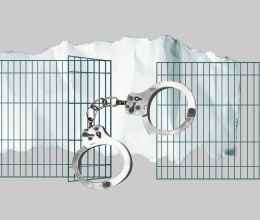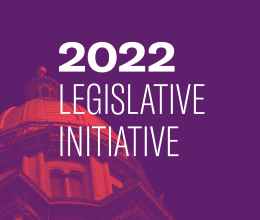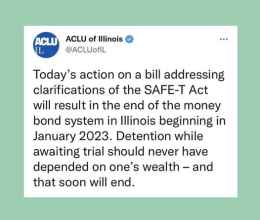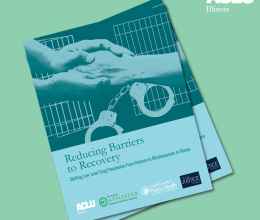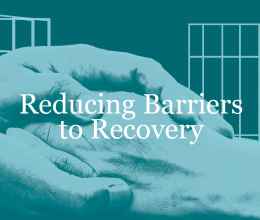
The story of mass incarceration in Illinois is a familiar one. Our state’s experience has mirrored the national trend of skyrocketing incarceration rates which took flight in the 1970’s and peaked fewer than 10 years ago, driven by punitive policies enacted in legislatures and fueled by “tough on crime” political rhetoric.
Although these harsh penalties often were presented as appropriate punishment for those who threaten our neighborhood’s safety and security, the reality is that they simply created overly-long sentences even for non-violent offenses. As an example, a person who steals items from a neighbor’s unoccupied garage faces a mandatory prison sentence of 4-15 years in Illinois. Even if it is a first offense, probation is not an option. And a judge passing this sentence is not able to consider any other factors, including what circumstances might have led to the criminal activity.
So, like other states, Illinois has seen an explosion in those behind bars. In 1980, Illinois’ prison population was 11,768. Today, it stands at more than 30,000, after reaching a historic peak of nearly 50,000 in 2013.Across the country, the United States incarcerates its own people at a much higher rate than any other country in the world: more than 2 million people are incarcerated nationwide, most of them in State prisons and local jails.
The biggest drivers of Illinois’ prison population have been sentencing policies that significantly increased the length of prison sentences: the unsuccessful War on Drugs, mandatory minimums, three strikes, and truth in sentencing. While the ostensible reason for these changes was to reduce crime, in fact overall rates of violent and property crime have been declining for decades even as more punitive sentencing policies took hold.
The reality is that increasing the severity of sentences does little to deter or reduce crime, but the overuse of incarceration has actually harmed public safety in communities where its impact is concentrated, especially within communities of color. These harmful policies drain these communities of economic resources, break up families, and contribute to social conditions that produce intergenerational cycles of over-policing, trauma, and incarceration.
Illinois’ Black and Latinx communities have borne the brunt of these misguided laws. While Black Illinoisans make up 14.5% of the State’s population, the prison population is 54.8% Black. Black people are imprisoned at 8.8 times the rate of whites—one of the worst disparities of any state. And the COVID-19 pandemic has revealed that our overuse of prisons and jails also jeopardizes public health and deepens existing social inequities.
Along the path to our current predicament, there have been moments of self-reflection by Illinois policymakers. When the state’s incarcerated population was exploding, there were no fewer than four different task forces and commissions tasked with recommending reforms to address failures in our criminal legal system. As recently as 2015, a bipartisan Commission was appointed by former Governor Rauner to formulate policies that would reduce Illinois’ prison population and create a less punitive and more rehabilitative criminal legal system.
Like the expert panels that preceded it, the Commission’s work led to policy recommendations which - had they actually been implemented - would have resulted in more families staying together, fewer people returning to communities with criminal histories weighing them down, and more investment in communities. But, like the plans put forth under prior Governors, few of the Commission’s recommendations were ever implemented.
Today, there are still far too many people in Illinois prisons who could be safely released, and many who never should have been sent there in the first place. The Illinois Department of Corrections budget alone is $1.5 billion a year, far too much for people in our state to support an unjust system that produces little public safety benefit.
ACLU polling shows that most Illinois voters support lawmakers committed to reducing incarceration, and support taking significant steps to reform sentencing in Illinois’ criminal legal system. These findings belie the widely held view that the public would be opposed to such changes in sentencing for fear of a political attack labeling an officeholder as “soft on crime.”
In this moment, we have a unique opportunity. The Illinois prison population is at its lowest level in 20 years as a result of declining arrests for drug and property crime, as well as temporary holds on transfers from county jails to state prisons during the pandemic. After decades of making policy based on anecdotes and political mailers, lawmakers have finally begun to demand and rely upon data around our use of prisons and jails. At the same time, people across the country are finally awakening to the ugly reality that racism is deeply ingrained in many of our institutions, especially in policing and the criminal legal system, and demanding change.
Governor Pritzker recently unveiled seven “principles to build a more equitable criminal justice system,” including modernizing sentencing laws for drug and property crimes and reducing the length of excessive prison stays. “[W]e spend billions of dollars a year keeping too many people in an overcrowded prison system that has proven itself too expensive, too punitive and wholly ineffective at keeping Illinois families safe,” said the Governor. “As we move forward with the General Assembly to pass comprehensive criminal justice reform, it is my hope that the nation will look to Illinois as a leader in true equity and justice for generations to come."
Illinois must not turn back. The time has come for real sentencing reform, and we must commit to these four essential elements to have real impact:
- Reducing minimum sentences and eliminating mandatory minimums.
- Reclassifying minor drug and property offenses.
- Reducing the length of commitments to the Department of Corrections.
- Applying reforms retroactively to currently incarcerated people.
